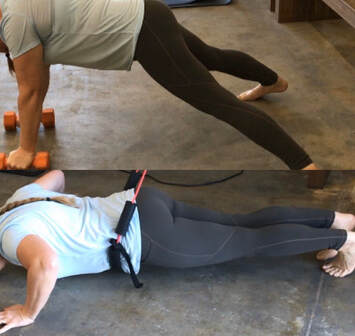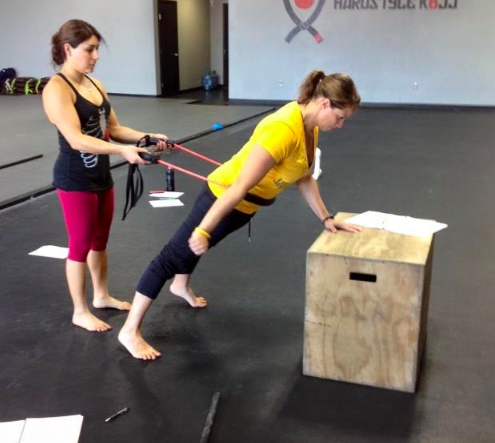|
“Girl push ups.” Such a horrible term. Thankfully, the term is not used so much anymore, giving way to the less derogatory “push ups on knees.” But terminology aside, I would argue that this form of push ups should probably be retired as well no matter what we call it. If you want to give yourself the best opportunity to achieve one good push up or give yourself the best opportunity to do even more good push ups, then I believe there are much better methods to accomplish the goal, several if which I will cover in this post. Don’t get me wrong…If someone just wants to crank out the reps and get a good ol chest burn, then have at it! But if the goal is to achieve your maximum physical potential, manipulating other variables is a better approach. The simple reason is that taking the push up down to the knees turns it into a different movement pattern. The push up is not just a chest movement – it also involves control of everything below, and even demands mobility from the feet, ankles and hamstrings. Check this out: Here’s a group fitness member who some would label as having a “weak core” based on the picture. But would you believe her problem was actually a painful right big toe, which she is understandably hesitant to bend! When we offloaded her lower body with the band, she was able to place more weight into her legs and successfully perform a complete push up movement. Had she gone down to her knees, she would be missing out on all those positive qualities we experience from a regular push up position. Position – First a story..During my final December lab of PT school, we had a charity race scheduled to raise money for a humanitarian PT mission to Haiti. The only problem was snow the night before the race! Not a problem in many places, but for Knoxville, Tennessee it felt like some biblical catastrophe. With no race, the organizers were left with a batch of prizes on their hands…How does a PT class distribute prizes when they can’t do a run? A plank contest!! Fast forward 11 minutes later when I was the last one standing (cuz I was planking). For my efforts I got this snazzy water bottle and a lifetime’s worth of bragging rights. And a sore stomach and shoulders too! The point of this story of self-adulation is this: before you can do a push up, you need to own the start position. Maybe not for 11 minutes, but you should at least demonstrate control. And when you spend some time there, you soon realize how much more goes into a push up than just the actual pushing. But before holding the position there is getting into the position. We can practice this by doing walk outs, as shown below. Don’t underestimate the importance of learning to find your start position easily. This drill is basically a form of interval planks, where your recovery is walking your hands out of the full planked position. Movement – Practicing the push up movement. If you can’t do a full push up, fear not! The simplest way is to bring the ground up to you. This might be at the wall or it might be on a slight incline. When doing these at an incline or the wall, remember to position your feet the same way as if you’re doing full push ups. Another method I like to apply is only working the descent, or negatives. Set up and begin the push up as normal, but when you get to the bottom, safely bail out and then reset for the next rep. Partial reps are another useful tactic by setting something like a yoga block beneath your chest so you can gauge your depth for progress. Resistance – Resistance as applied to a bodyweight push up is simply the gradual reduction in height until you’re at ground level (and if you want to go beyond, then you can explore different hand positions, decline and adding weight). You also add resistance by doing a partial rep down to your “sticking point” (where you can’t go any further under control) Speed – Even when people get the first three parts correct, the push up can still look like a painful grind, even if technique is sound. To achieve proficiency, we need to inject some speed. One way is with the band. Also note, this is another way to allow people to “stick with group” if they don’t want to do any of the other drills that are done at different rhythm than full push-ups. In addition, you can also combine drills, as shown below, where we are using banded assistance combined with elevation to help a student toward her one arm push up. Even when we advance to that level, the same principles apply… Rehab applications
Many people complain that push ups bother their shoulders. But what if the real issue isn’t in the shoulders but instead in the way the rest of the body is moving, causing added stress to be placed onto the shoulders? During that epic plank contest (did I mention I won?) , as my core started to fatigue, one strategy that I used was to shift the load onto my shoulder joints. Healthy? No. Effective to stay upright? Yes. Its very likely that the same thing happens on a smaller scale when the rest of the body isn’t hold up its part of the bargain to support the arms. When someone complains of shoulder pain caused by push ups, the first place to look is often far away from the shoulder. Bottom line There are several alternatives to performing push ups on your knees if you can’t perform a complete push up from the ground. In my experience, these methods are more effective to progress someone toward a complete push ups. To have them keep pushing from their knees without formulating a plan to progress them toward the ultimate goal of a complete push up is a disservice and may deprive them of a monumental achievement in their fitness journey. Allan Phillips, PT, DPT Physical therapy, Oro Valley
1 Comment
|
AuthorAllan Phillips, PT, DPT is owner of Ventana Physiotherapy Archives
December 2023
Categories
All
|
2951 N. Swan Rd.
Suite 101, inside Bodywork at Onyx
Tucson, Arizona 85712
Call or Text: (520) 306-8093
[email protected]
Terms of Service (here)
Privacy Policy (here)
Medical disclaimer: All information on this website is intended for instruction and informational purposes only. The authors are not responsible for any harm or injury that may result. Significant injury risk is possible if you do not follow due diligence and seek suitable professional advice about your injury. No guarantees of specific results are expressly made or implied on this website.
Privacy Policy (here)
Medical disclaimer: All information on this website is intended for instruction and informational purposes only. The authors are not responsible for any harm or injury that may result. Significant injury risk is possible if you do not follow due diligence and seek suitable professional advice about your injury. No guarantees of specific results are expressly made or implied on this website.
Proudly powered by Weebly




 RSS Feed
RSS Feed